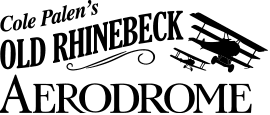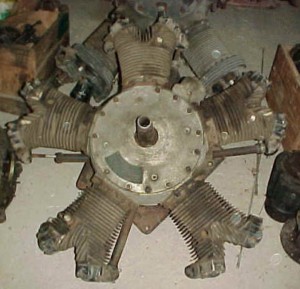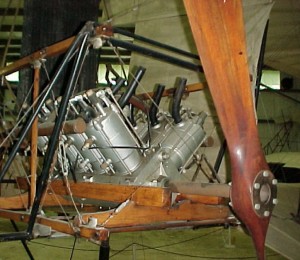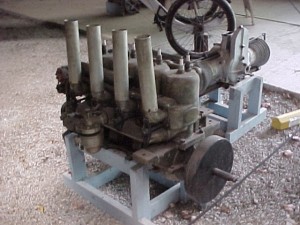ABC Wasp

Country: United Kingdom
Year: 1916
Horsepower: 170
RPM: 1750
Weight: 290 lbs
Displacement: 667 cu. in.
Configuration: 7 cylinder radial air-cooled
Used in: Westland Wagtail, Sopwith Snail
Description: The ABC was one of the first large stationary air-cooled radials. The temper-mental engine had the best power-to-weight ratio of any engine to date. This advanced stationary radial engine concept prompted the design of the larger 302 HP Dragonfly version which was a failure.
Anzani
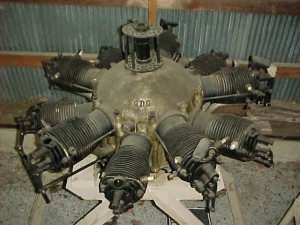
Country: France
Year: 1915
Horsepower: 100-110
RPM: 1,150
Weight: 308 lbs
Displacement: 739 cu. in.
Configuration: 10 cylinder radial, air-cooled
Used in: Caudron G.III & G.IV
Description: Motorcycle builder Alessandro Anzani produced the first practical static radial, air-cooled aircraft engine in 1909. By 1913 he had seven engine designs available including a 2-row, 10 cylinder version.
Armstrong-Siddely Genet
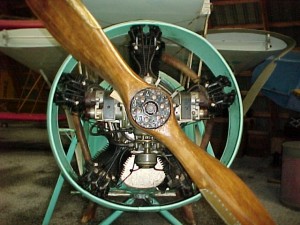
Country: United Kingdom
Year: 1926
Horsepower: 82
RPM: 2200
Weight: 203 lbs
Displacement: 251 cu. in.
Configuration: 5 cylinder radial, air-cooled
Used in: Nicholas-Beazley
Description: The Genet was one of numerous designs produced by Armstrong-Siddely from 1917 through the 1950s. This example is seen fitted to the museum’s Nicholas Beazley NB-8G.
Arrow Model F
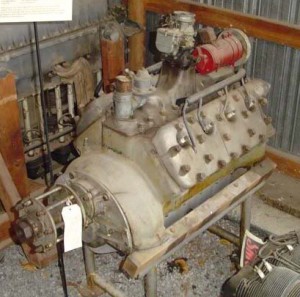
Country: United States
Year: 1935
Horsepower: 82
RPM: 3,075
Weight: 402 lbs
Displacement: 221 cu. in.
Configuration: V-8 liquid cooled
Used in: Arrow Sport F
Description: This engine was developed from the Ford V-8 automobile engine and was approved for aircraft use after stringent govern- ment testing. The Arrow Sport aircraft (for which it was produced) used a pull-starter in the cockpit similar to the type found on a lawnmower.
Cirrus Minor
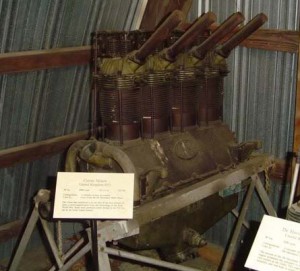
Country: United Kingdom
Year: 1925
Horsepower: 90
RPM: 2,600
Weight: 205 lbs
Displacement: 220 cu. in.
Configuration: 4 cylinder in-line, air-cooled
Used in: Avro Avian III, De Havilland Moth Minor
Description: The Cirrus was considered to be the first of the four-cylinder in-lines to move significantly from the technology of the First World War. Some were produced under license in the U.S. for use in Great Lakes trainers.
Clerget 9B
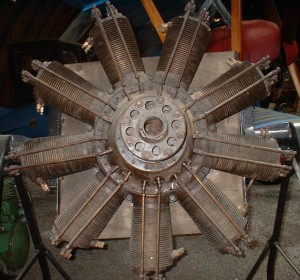
Country: France
Year: 1917
Horsepower: 130
RPM: 1250
Weight: 381 lbs
Displacement: 381 cu. in.
Configuration: 9 cylinder rotary, air-cooled
Used in: Sopwith Camel, Triplane,Baby & 1-1/2 Strutter
Description: The Clerget was a well-engineered engine, but the 9B suffered from overheating problems. Gwynnes Ltd. in London (known to produce the finest engines of this type) built the example on display.
Continental A-40
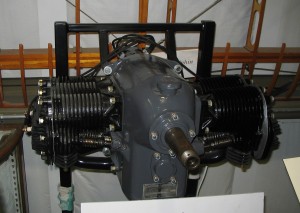
Country: United States
Year: 1931
Horsepower: 37
RPM: 2250
Weight: 144 lbs
Displacement: 115 cu. in.
Configuration: 4 cylinder opposed, air-cooled
Used in: Taylor E-2 Cub, Piper J-2 Cub
Description: The A-40 was responsible for keeping private flying alive during the Depression more than any other aircraft engine. It was also considered to be the simplest four-stroke aircraft engine ever built.
Continental W-670
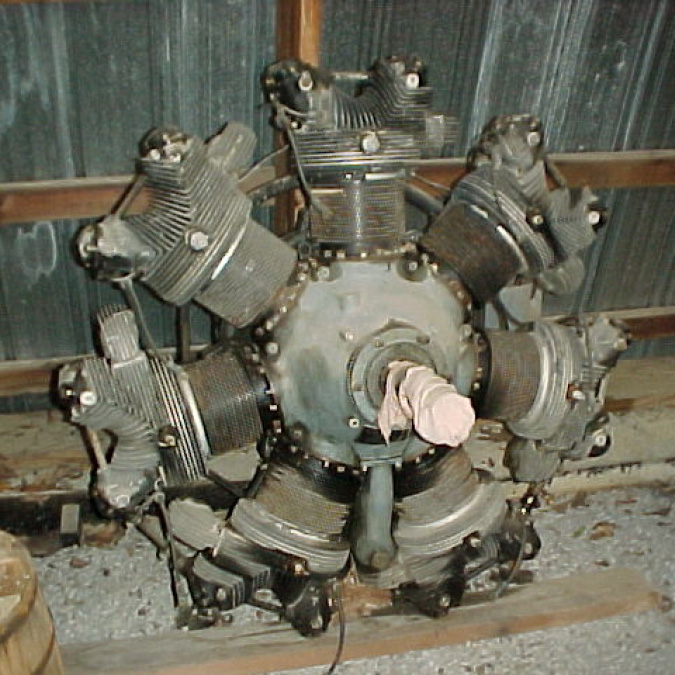
Country: United States
Year: 1934
Horsepower: 210-240
RPM: 2200
Weight: 415 lbs
Displacement: 668 cu. in.
Configuration: 7 cylinder radial, air cooled
Used in: Stearman PT-17, Waco UPF-7, N3N
Description: Originating in the mid-thirties, the W-670 was updated through the Second World War and was widely used in primary training aircraft of the U.S. military. In the post-war years many were used in crop-dusters. A slightly different version of the W-670 was developed for use in tanks.
Curtiss
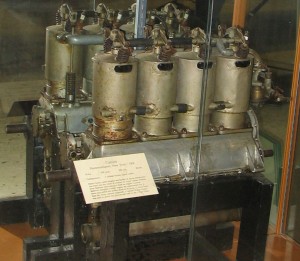
Country: United States
Year: 1908
Horsepower: 25
RPM: 1200
Weight: 192 lbs
Displacement: 300 cu. in.
Configuration: 4 cylinder in-line, liquid cooled
Description: Glenn Curtiss, noted designer and builder of racing motorcycles, was lured into the world of aviation by Army Captain Thomas Scott Baldwin when asked to build an engine to power Baldwin’s dirigible. Curtiss’ engine ran continuously for 2 hours and pulled the airship along at 23 m.p.h. (three times faster than the Army contract required!). A similar Curtiss engine was used to power the first aircraft sold in the United States. (Baldwin’s engine: 4 cylinder E-4)
Curtiss C-6
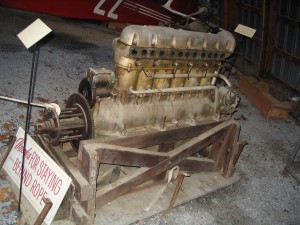
Country: United States
Year: 1918
Horsepower: 160
RPM: 1750
Weight: 448 lbs
Displacement: 573 cu. in.
Configuration: 6 cylinder in-line, liquid-cooled
Used in: Walter Beech’s early Travel-Air 2000, Curtiss Seagull
Description: An excellent post-war effort, but could not compete in price with new surplus OX-5 engines which were selling for as little as $50.
Curtiss Challenger

Country: United States
Year: 1927
Horsepower: 180
RPM: 2000
Weight: 420 lbs (Dry)
Displacement: 603.4 cu. in.
Configuration: 6 cylinder radial, air-cooled
Used in: Curtiss Robin
Curtiss OX-5
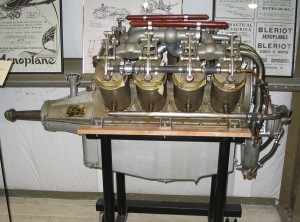
Country: United States
Year: 1910
Horsepower: 90
RPM: 1400
Weight: 320 lbs (Dry)
Displacement: 503 cu. in.
Configuration: V-8 liquid cooled
Used in: Curtiss Jenny, Waco 10, Curtiss Robin
Description: When the OX-5 went into full-scale production in 1917, it was already considered obsolete. Despite its shortcomings it became the mainstay of the American training while used in the popular Curtiss Jenny. It was used in new production aircraft as late as 1930.
Detroit Aero Engine

Country: United States
Year: 1909
Horsepower: 30/40
RPM: 1200
Weight: 110 lbs
Displacement: 196 cu. in.
Configuration: 2 cylinder opposed, air-cooled
Description: The Detroit Aero engine was the lowest priced early engine available enabling a large number of aviation enthusiasts who were not wealthy to pursue the dream of flight.
DeHavilland Gipsy 1

Country: United Kingdom
Year: 1928
Horsepower: 90
RPM: 2100
Weight: 285 lbs
Displacement: 318 cu. in.
Configuration: 4 cylinder in-line, air-cooled
Used in: De Havilland Gipsy Moth
Description: The success of the De Havilland Moth powered by the Cirrus engine prompted the company to develop an engine of their own known as the Gipsy. This engine was known for its durability and was kept in production until 1934.
DeHavilland Gipsy Major
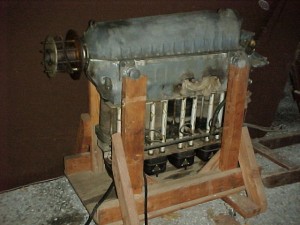
Country: United Kingdom
Year: 1932
Horsepower: 130-145
RPM: 2350
Weight: 305 lbs
Displacement: 374 cu. in.
Configuration: 4 cylinder in-line, air cooled
Used in: De Havilland Tiger Moth, DH.87
Description: Developed from the earlier Gipsy I, II & III, the Major was designed to run in an inverted position with the cylinders pointing downward. 14, 615 were produced accounting for one half of all the Gipsy engines combined.
Elbridge Featherweight

Country: United Kingdom
Year: 1911
Horsepower: 40
RPM: 1400
Weight: 198 lbs
Displacement: 330 cu. in.
Configuration: 4 cylinder in-line, liquid cooled
Used in: Clyde Cessna’s first aircraft, The Silverwing
Description: Specializing in two-stroke marine engines, Elbridge branched into the aviation market when aircraft builders discovered their lightly-constructed designs prior to 1910. In 1911 the firm began to advertise their engines as “Featherweights” to target aircraft builders. Modular construction allowed the Elbridge to be built in three-, four-, or six-cylinder versions.
ENV
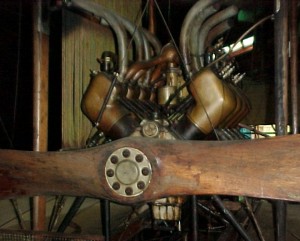
Country: United Kingdom / France
Year: 1909
Horsepower: 60
RPM: 1100
Weight: 287 lbs
Displacement: 464 cu. in.
Configuration: V-8, water-cooled
Used in: Short S-29, Bleriot XII, Hanriot
Description: Designed in England and built in France, this engine was considered to be one of the best of its time period. The name derives from the French “en V”, describing the V-8 configuration. The Aerodrome’s Short-29 reproduction was built by Cole Palen specifically to serve as a home for this well-liked engine.
Fairchild Ranger 6-440
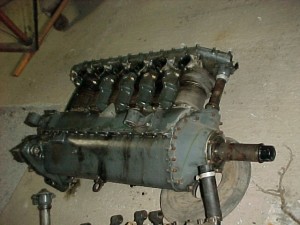
Country: United States
Year: 1930
Horsepower: 175-200
RPM: 2450
Weight: 376 lbs
Displacement: 440 cu. in.
Configuration: 6 cylinder in-line, air-cooled
Used in: Fairchild PT-19, PT-26 and Grumman Widgeon
Description: 6.600 Ranger “sixes” were built being used almost exclusively in Fairchild aircraft. This make the total Ranger production greater than that of most other contemporary engine types.
Fairchild Ranger-V-770

Country: United States
Year: 1931
Horsepower: 300-520
RPM: 2150
Weight: 565 lbs
Displacement: 772 cu. in.
Configuration: V-12, air cooled
Used in: Curtiss SOC-3, Fairchild experimental designs
Description: The Curtiss Seagull was the only production aircraft to use the 770. It was considered to be one of America’s worst aircraft of W.W.II. The engine would tend to overheat and quit without warning when the Seagull was flown slowly.
Franklin 4AC-150
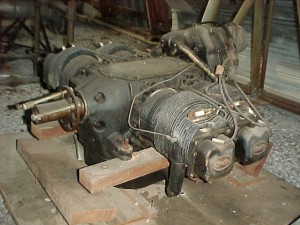
Country: United States
Year: 1938
Horsepower: 50
RPM: 2150
Weight: 156 lbs
Displacement: 150 cu. in.
Configuration: 4 cylinder opposed
Used in: Aeronca Chief
Description: TIn 1938, the Air Cooled Motors Development Co. opened for business when several engineers of the defunct Franklin Automobile Co. bought the bankrupt company’s assets. The 4AC-150 was the first product to retain the Franklin name.
Gnome B-2
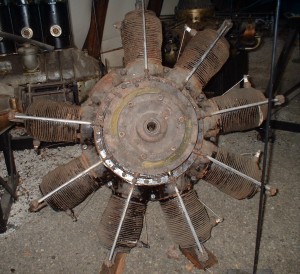
Country: France
Year: 1914
Horsepower: 100
RPM: 1200
Weight: 272 lbs
Displacement: 782 cu. in.
Configuration: rotary, 9 cylinder, air cooled
Description: This example was built by the General Vehicle Company in Long Island City, New York, and was used in Cole Palen’s first Fokker triplane until a cylinder departed the engine in mid-flight. Cole landed safely but later said it was the worst experience he ever had in an airplane.
Gnome Delta
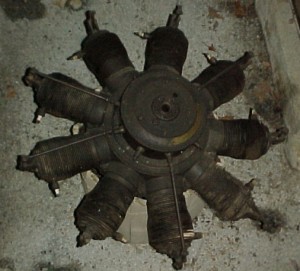
Country: France
Year: 1914
Horsepower: 100
RPM: 1200
Weight: 297 lbs
Displacement: 994 cu. in.
Configuration: rotary, 9 cylinder, air cooled
Used in: De Havilland DH.2, Sopwith Pup & Camel
Description: Gnome types were known as Monosoupape (single valve) meaning one valve was used for both inlet and exhaust gases. Because of this Gnomes ran at one speed…wide open.
Heath Henderson
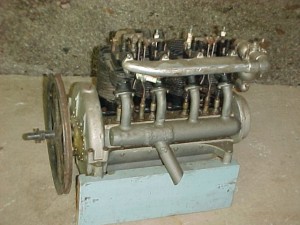
Country: United States
Year: 1925
Horsepower: 30
RPM: 3000
Displacement: 83 cu. in.
Heath Henderson B-4
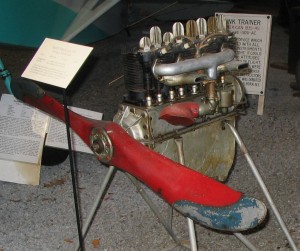
Country: United StatesYear: 1928
Horsepower: 30
RPM: 3000
Weight: 119 lbs
Displacement: 83 cu. in.
Configuration: 4 cylinder in-line, air-cooled
Used in: Heath Parasol, Dormoy Bathtub
Description: The B-4 was developed as an aircraft conversion of the Henderson motorcycle engine for Ed Heath’s Parasol. In the late twenties and early thirties it was not uncommon to find converted motorcycle engines in home-built aircraft.
Herreshoff
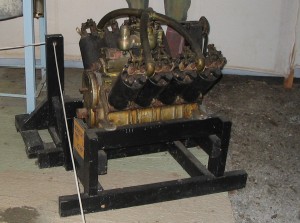
Country: United States
Year: 1910
Horsepower: 40
Configuration: V-8
Hispano-Suiza
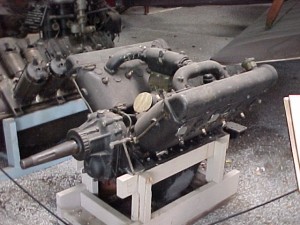
Country: Spain
Year: 1918
RPM: 2200
Configuration: V-8, geared, liquid-cooled
Used in: S.E.5a
Description: Marc Birkigt established Hispano-Suiza (meaning Spanish-Swiss) in Spain in 1904. By 1918 H.S. engines were in production all over the world from the U.S.A. to Russia. They were exceptionally reliable, and later versions set many records.
Hispano-Suiza E
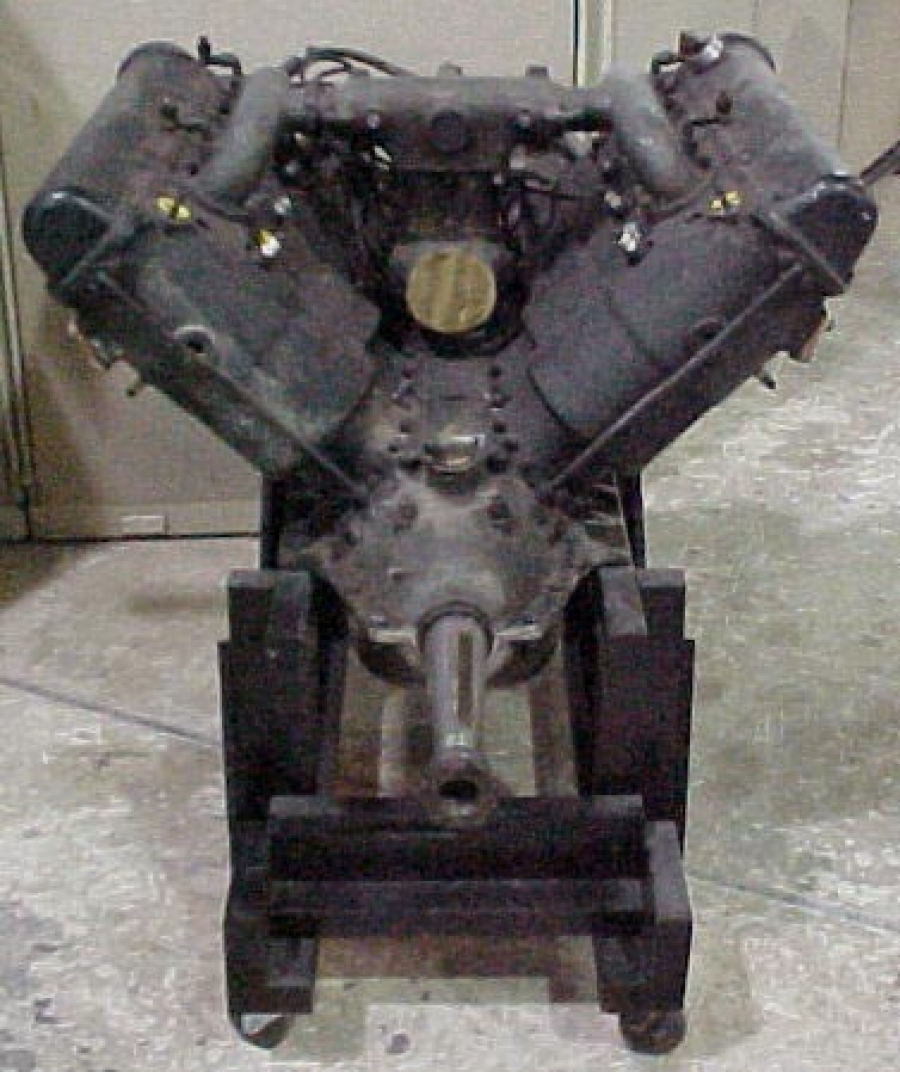
Country: Spain
Year: 1916
Horsepower: 180
RPM: 1600
Weight: 467 lbs
Displacement: 718 cu. in.
Configuration: V-8, stationary, liquid-cooled
Used in: S.E.5a, SPAD VII & XIII, Sopwith Dolphin
Jacobs R-755
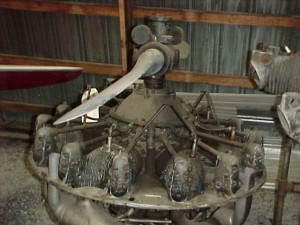
Country: United States
Year: 1943
Horsepower: 275
RPM: 3000
Weight: 505 lbs
Displacement: 757 cu. in.
Configuration: 7 cylinder radial, air-cooled
Used in: Cessna 195, AT-17, UC-78 and Crane
Description: The R-755 was used in to power a large percentage of U.S. twin-engined trainers. It was simply-designed and reliable. Jacobs engines are still in production today.
Kemp Grey Eagle Model D-4
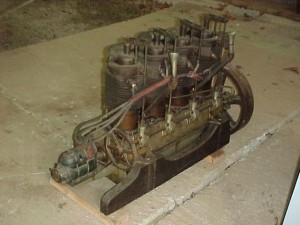
Country: United States
Year: 1912
Horsepower: 35
RPM: 1150
Weight: 200 lbs
Displacement: 217 cu. in.
Configuration: 4 cylinder in-line
Kinner B-5

Country: United States
Year: 1930
Horsepower: 125
RPM: 1925
Weight: 295 lbs
Displacement: 441 cu. in.
Configuration: 5 cylinder radial, air-cooled
Used in: Fleet Models 7-9, Monocoupe, Kinner Sportster
Description: Though not the most streamlined of engines, the Kinner was appreciated for its durability, reliability and economical operation.
Kinner K-5
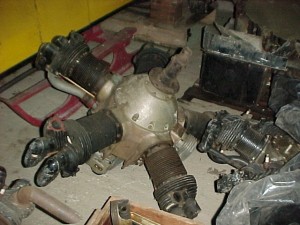
Country: United States
Year: 1927
Horsepower: 100
RPM: 1810
Weight: 275 lbs
Displacement: 372 cu. in.
Configuration: 5 cylinder radial, air-cooled
Used in: Fleet Model 2, Mohawk Pinto, Kinner Sportster, Bird
Description: Established in 1919, Kinner produced engines through 1945. Thousands were used in wartime trainers and their distinctive clattering and long , slender cylinders on a small crankcase were characteristic of all Kinners
Lawrance A-3
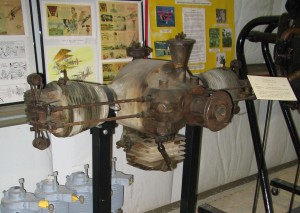
Country: United States
Year: 1917
Horsepower: 28
RPM: 1400
Weight: 200 lbs
Configuration: 2 cylinder opposed, air-cooled
Used in: Shinnecock light plane, Penguin ground trainers
Description: The opposed pistons of this engine working off the same crank resulted in excessive vibration. A Navy contract for 50 engines was awarded to the company; however, the facility (in a NYC loft) was not adequate for production. Wright Aeronautical purchased Lawrance along with the contract.
LeBlond 66
Country: United States
Year: 1928
Horsepower: 65
RPM: 1950
Weight: 240 lbs
Displacement: 251 cu. in.
Configuration: 5 cylinder radial, air-cooled
Used in: Davis V-3, Kari-Keen Coupe
Description: The LeBlond company (who were famous for their quality machine tools) produced a small line of engines up to the outbreak of W.W.II. Although many LeBlonds were used in Rearwin aircraft, the aircraft engine business did not live up to company President Richard LeBlond’s expectations.
Le Rhône
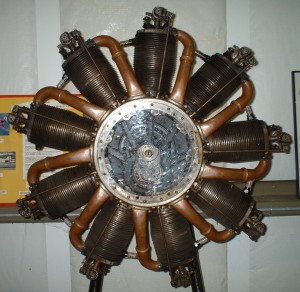
Country: France
Year: 1912
Horsepower: 80
RPM: 1200
Weight: 268 lbs
Displacement: 667 cu. in.
Configuration: 9 cylinder rotary, air-cooled
Used in: Nieuport XI, Sopwith Pup
Description: Le Rhône rotaries were produced in large scale in France and Sweden. The Union Switch and Signal Company in Swissvale, Pennsylvania also manufactured these types. The Le Rhône used less fuel and oil than the contemporary Gnome and was cheaper, lighter and could idle smoothly at low R.P.M.s
Le Rhône 9J
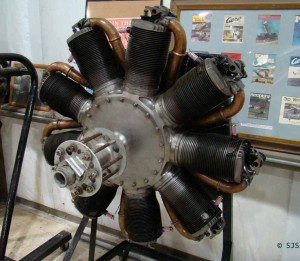
Country: France
Year: 1914
Horsepower: 110
RPM: 1200
Weight: 308 lbs
Displacement: 919 cu. in.
Configuration: 9 cylinder rotary, air-cooled
Used in: Avro 504, Bristol M.1
Description: The Le Rhone 9J was produced in France by Gnome et Rhône, and under license in Great Britain. The type was also copied in Germany where it was known as the Oberursel Ur.II. This Le Rhône powered the museum’s Avro 504K reproduction for many years until it was retired in 2009.
Liberty
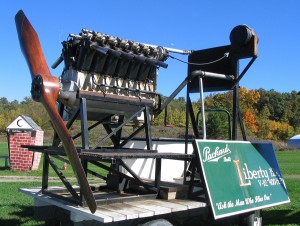
Country: United States
Year: 1918
Horsepower: 420
RPM: 1700
Weight: 844 lbs
Displacement: 1649 cu. in.
Configuration: V-12, liquid -cooled
Used in: De Havilland DH-4, Douglas N-2, Curtiss Falcon
Description: Produced in large numbers and used extensively in mail planes following the War, the Liberty was a significant U.S. contribution to aviation. Jesse Vincent of Packard and E.J. Hall of Hall-Scott designed the engine in five days. One month later the first prototype was built and running.
Rinek B-8
Country: United States
Year: 1909
Horsepower: 40-60
RPM: 1200
Weight: 300 lbs
Displacement: 572 cu. in.
Configuration: V-8, water-cooled
Used in: Rinek Voisin
Description: The engines built by Norvin Rinek’s company were the first 8 cylinder water-cooled types to be made in the U.S.A. for aircraft use. Rinek’s most notable contribution to aviation was his introduction and application of specialized materials to both engine and aircraft design that combined strength, durability and light weight.
Roberts-Model-P
Country: United States
Year: 1911
Horsepower: 40
RPM: 1400
Weight: 165 lbs
Displacement: 318 cu. in.
Configuration: 4 cylinder in-line, liquid-cooled
Used in: Ecker Flying Boat, Benoist Flying Boat
Description: The Roberts, being a two-cycle design, consumed more fuel, was more difficult to start and required more attention to keep running than its four-cycle contemporaries. By 1914 it was obsolete.
Salmson-AB
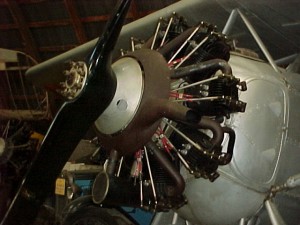
Country: France
Year: 1929
Horsepower: 230
RPM: 1700
Weight: 583 lbs
Displacement: 1146 cu. in.
Configuration: 9 cylinder radial
Used in: Morane Saulnier M.S.130
Description: Salmson entered the aero engine business in 1911 and concentrated their efforts on the static radial configuration. From 1920 on, all Salmson engines were entirely air-cooled. The company was liquidated in 1951.
Salmson-AD-9
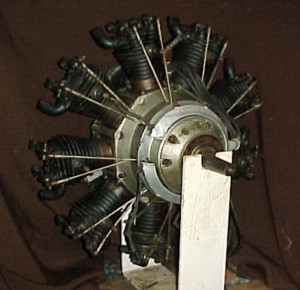
Country: France
Year: 1925
Horsepower: 40
RPM: 2000
Weight: 150 lbs
Displacement: 182 cu. in.
Configuration: 9 cylinder radial
Used in: Aeromarine Klemm, American Eaglet
Description: Known for its smooth operation and small size, the 9AD was dubbed the “watch-charm engine”.
Siemens Halske SH12
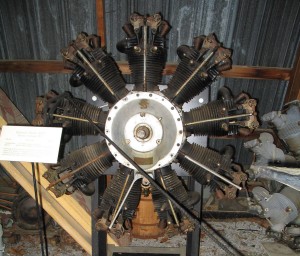
Country: Germany
Year: 1932
Horsepower: 120
RPM: 1750
Weight: 381 lbs
Configuration: 9 cylinder radial
Used in: Udet Flamingo (100 HP), Bucker Jungmeister (150 HP)
Description: Following World War I, Germany’s production of high performance engines was limited in compliance with the Versailles Treaty. Engineers placed their emphasis on aerodynamics to produce aircraft that performed well with low H.P. engines.
Szekely SR-3L
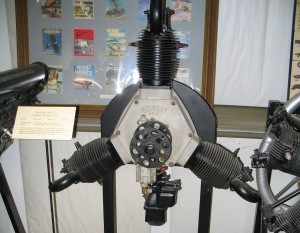
Country: United States
Year: 1929
Horsepower: 30
RPM: 1750
Weight: 152 lbs
Displacement: 191 cu. in.
Configuration: 3 cylinder radial, air-cooled
Used in: Curtiss Wright Junior, Buhl Bull-Pup
Description: A 35 h.p. version of the Szekely (SR-3-35) was used in the Taylor H-2 Cub, only a handful of which were made. Beverly Dodge and a passenger set the women’s altitude record (16, 800′) in 1937 in a Szekely powered Taylor H-2.
Szekely SR-3 O
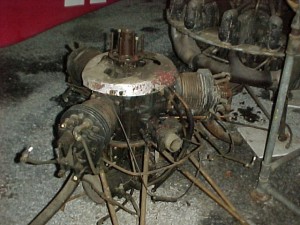
Country: United States
Year: 1931
Horsepower: 45
RPM: 1750
Weight: 152 lbs
Displacement: 191 cu. in.
Configuration: 3 cylinder radial, air-cooled
Used in: Curtiss Wright Junior, American Eaglet
Description: The Depression forced flying minded consumers and manufacturers to explore more economical alternatives for flying. Curtiss-Wright managed to stay in business when they purchased the rights to the C.W. Junior design, equipped them with Szekely engines and met with great success.
Union Dirigible
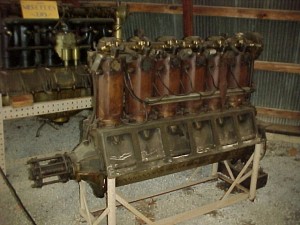
Country: United States
Year: 1918
Horsepower: 125
RPM: 1400
Weight: 485 lbs
Displacement: 691 cu. in.
Configuration: 6 cylinder in-line, liquid-cooled
Used in: Dirigibles
Description: Low fuel-and oil-consumption, light-weight, simplicity of design and reliability made the Union a desirable source of power for airships.
Velie M-5
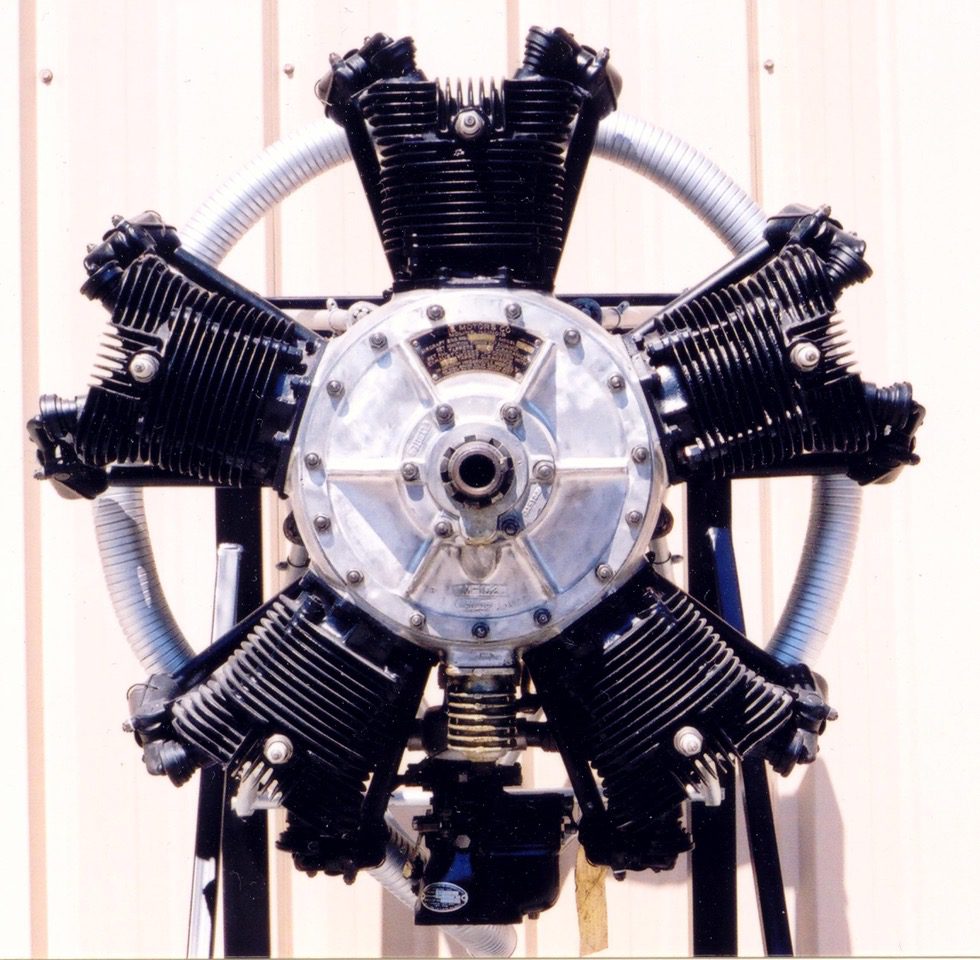
Country: United States
Year: 1928
Horsepower: 65
RPM: 1900
Weight: 240 lbs
Displacement: 251 cu. in.
Configuration: 5 cylinder radial, air-cooled
Used in: Monocoupe 70 and 113, Monoprep 218
Description: This example came from the Anthony Fokker apprentice shop when he had his factory in New Jersey and was most likely used to teach apprentices how to assemble and disassemble aircraft engines. Anthony Fokker had a mansion in Nyack, NY, and when the factory closed down he brought some of the items from his shop to one of the barns on his property. Jane King, (wife of Aerodrome pilot, Bill King) knew a lady whose family ran the Fokker mansion. In her later years she learned that they were cleaning out the barn and she contacted Jane to see if Bill was interested in anything that had been in storage there. In addition to the Velie there were a few propellers, and some printing blocks with views of the Fokker factory.
Bill talked about the value of the engine with Cole Palen and then he purchased it for about $350 in the early 1980s. Bill felt it would make a nice display for our museum and Cole had a Gipsy engine that Bill needed for his Tiger Moth. They made the trade and the Velie became part of the Aerodrome collection.
Warner-Scarab

Country: United States
Year: 1927
Horsepower: 125
RPM: 2050
Weight: 275 lbs
Displacement: Approx. 372 cu. in.
Configuration: 7 cylinder radial, air-cooled
Used in: Cessna AW, Monocoupe 110, Monosport 1
Description: The Scarab received wide acceptance at the 1928 National Air Races when Warner powered aircraft dominated their classes. They were exceptionally smooth-running engines.
Wright 6-60
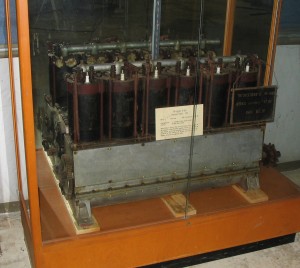
Country: United States
Year: 1911
Horsepower: 60
RPM: 1150
Weight: 230 lbs
Displacement: Approx. 400 cu. in.
Configuration: 6 cylinder in-line, liquid cooled
Used in: Wright Baby Grand
Description: With Wilbur Wright’s death in 1912, the 6-60 became one of the last of the original Wright brothers’ engines. Orville did not keep up with rapidly advancing technology and their last engine was produced in 1915; however, the Wright name did live on in engines produced through the 1960s.
Wright-Hispano H-3
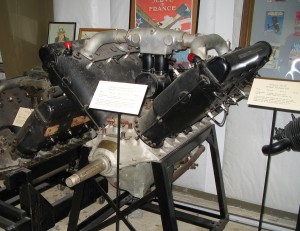
Country: United States
Year: 1922
Horsepower: 300
RPM: 1800
Weight: 528 lbs
Displacement: Approx. 1127 cu. in.
Configuration: V-8, stationary, liquid cooled
Used in: Sopwith Dolphin, Mk.II, SPAD, S.17, –Nieuport 29
Description: The Wright Aeronautical Corporation in Patterson, New Jersey, built this example under license in 1922. Through- out their production life Hispano-Suiza engines were refined to become among the most reliable engines available.
Wright Whirlwind J-5

Country: United States
Year: 1926
Horsepower: 220
RPM: 1800
Weight: 510 lbs
Displacement: 788 cu. in.
Configuration: 9 cylinder radial, air-cooled
Used in: Spirit of St. Louis, Lockheed Vega, Waco
Description: The J-5 achieved sudden fame when Charles Lindbergh successfully crossed the Atlantic in May of 1927. The highest reliability of any aircraft engine to date had been demonstrated with this flight, and the event changed the way the world thought about air travel overnight.
